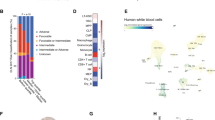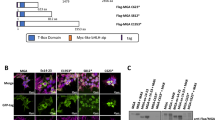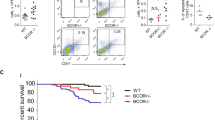Abstract
Modest transcriptional changes caused by genetic or epigenetic mechanisms are frequent in human cancer. Although loss or near-complete loss of the hematopoietic transcription factor PU.1 induces acute myeloid leukemia (AML) in mice, a similar degree of PU.1 impairment is exceedingly rare in human AML; yet, moderate PU.1 inhibition is common in AML patients. We assessed functional consequences of modest reductions in PU.1 expression on leukemia development in mice harboring DNA lesions resembling those acquired during human stem cell aging. Heterozygous deletion of an enhancer of PU.1, which resulted in a 35% reduction of PU.1 expression, was sufficient to induce myeloid-biased preleukemic stem cells and their subsequent transformation to AML in a DNA mismatch repair–deficient background. AML progression was mediated by inhibition of expression of a PU.1-cooperating transcription factor, Irf8. Notably, we found marked molecular similarities between the disease in these mice and human myelodysplastic syndrome and AML. This study demonstrates that minimal reduction of a key lineage-specific transcription factor, which commonly occurs in human disease, is sufficient to initiate cancer development, and it provides mechanistic insight into the formation and progression of preleukemic stem cells in AML.
This is a preview of subscription content, access via your institution
Access options
Subscribe to this journal
Receive 12 print issues and online access
$209.00 per year
only $17.42 per issue
Buy this article
- Purchase on Springer Link
- Instant access to full article PDF
Prices may be subject to local taxes which are calculated during checkout





Similar content being viewed by others
References
Orkin, S.H. Diversification of hematopoietic stem cells to specific lineages. Nat. Rev. Genet. 1, 57–64 (2000).
Iwasaki, H. et al. The order of expression of transcription factors directs hierarchical specification of hematopoietic lineages. Genes Dev. 20, 3010–3021 (2006).
Iwasaki, H. et al. Distinctive and indispensable roles of PU.1 in maintenance of hematopoietic stem cells and their differentiation. Blood 106, 1590–1600 (2005).
Dakic, A. et al. PU.1 regulates the commitment of adult hematopoietic progenitors and restricts granulopoiesis. J. Exp. Med. 201, 1487–1502 (2005).
Scott, E.W., Simon, M.C., Anastasi, J. & Singh, H. Requirement of transcription factor PU.1 in the development of multiple hematopoietic lineages. Science 265, 1573–1577 (1994).
Juliusson, G. et al. Age and acute myeloid leukemia: real world data on decision to treat and outcomes from the Swedish Acute Leukemia Registry. Blood 113, 4179–4187 (2009).
Jan, M. et al. Clonal evolution of preleukemic hematopoietic stem cells precedes human acute myeloid leukemia. Sci. Transl. Med. 4, 149ra118 (2012).
Hope, K.J., Jin, L. & Dick, J.E. Acute myeloid leukemia originates from a hierarchy of leukemic stem cell classes that differ in self-renewal capacity. Nat. Immunol. 5, 738–743 (2004).
Rosenbauer, F. et al. Acute myeloid leukemia induced by graded reduction of a lineage-specific transcription factor, PU.1. Nat. Genet. 36, 624–630 (2004).
Kuo, Y.H. et al. Cbfβ-SMMHC induces distinct abnormal myeloid progenitors able to develop acute myeloid leukemia. Cancer Cell 9, 57–68 (2006).
Krivtsov, A.V. et al. Transformation from committed progenitor to leukaemia stem cell initiated by MLL-AF9. Nature 442, 818–822 (2006).
Shimizu, R. et al. Leukemogenesis caused by incapacitated GATA-1 function. Mol. Cell. Biol. 24, 10814–10825 (2004).
Metcalf, D. et al. Inactivation of PU.1 in adult mice leads to the development of myeloid leukemia. Proc. Natl. Acad. Sci. USA 103, 1486–1491 (2006).
Cook, W.D. et al. PU.1 is a suppressor of myeloid leukemia, inactivated in mice by gene deletion and mutation of its DNA-binding domain. Blood 104, 3437–3444 (2004).
Steidl, U. et al. Essential role of Jun family transcription factors in PU.1 knockdown–induced leukemic stem cells. Nat. Genet. 38, 1269–1277 (2006).
Steidl, U. et al. A distal single-nucleotide polymorphism alters long-range regulation of the PU.1 gene in acute myeloid leukemia. J. Clin. Invest. 117, 2611–2620 (2007).
Yoshida, H. et al. PML–retinoic acid receptor α inhibits PML IV enhancement of PU.1-induced C/EBPɛ expression in myeloid differentiation. Mol. Cell. Biol. 27, 5819–5834 (2007).
Mueller, B.U. et al. ATRA resolves the differentiation block in t(15;17) acute myeloid leukemia by restoring PU.1 expression. Blood 107, 3330–3338 (2006).
Mizuki, M. et al. Suppression of myeloid transcription factors and induction of STAT response genes by AML-specific Flt3 mutations. Blood 101, 3164–3173 (2003).
Vangala, R.K. et al. The myeloid master regulator transcription factor PU.1 is inactivated by AML1-ETO in t(8;21) myeloid leukemia. Blood 101, 270–277 (2003).
Bonadies, N., Pabst, T. & Mueller, B.U. Heterozygous deletion of the PU.1 locus in human AML. Blood 115, 331–334 (2010).
Mueller, B.U. et al. Heterozygous PU.1 mutations are associated with acute myeloid leukemia. Blood 100, 998–1007 (2002).
Mao, G. et al. Preferential loss of mismatch repair function in refractory and relapsed acute myeloid leukemia: potential contribution to AML progression. Cell Res. 18, 281–289 (2008).
Zhu, Y.M., Das-Gupta, E.P. & Russell, N.H. Microsatellite instability and p53 mutations are associated with abnormal expression of the MSH2 gene in adult acute leukemia. Blood 94, 733–740 (1999).
Diouf, B. et al. Somatic deletions of genes regulating MSH2 protein stability cause DNA mismatch repair deficiency and drug resistance in human leukemia cells. Nat. Med. 17, 1298–1303 (2011).
Zhang, S., Lloyd, R., Bowden, G., Glickman, B.W. & de Boer, J.G. Thymic lymphomas arising in Msh2-deficient mice display a large increase in mutation frequency and an altered mutational spectrum. Mutat. Res. 500, 67–74 (2002).
Welch, J.S. et al. The origin and evolution of mutations in acute myeloid leukemia. Cell 150, 264–278 (2012).
Smits, R. et al. Somatic Apc mutations are selected upon their capacity to inactivate the β-catenin downregulating activity. Genes Chromosom. Cancer 29, 229–239 (2000).
Reitmair, A.H. et al. MSH2-deficient mice are viable and susceptible to lymphoid tumours. Nat. Genet. 11, 64–70 (1995).
Schmidt, M., Bies, J., Tamura, T., Ozato, K. & Wolff, L. The interferon regulatory factor ICSBP/IRF-8 in combination with PU.1 upregulates expression of tumor suppressor p15Ink4b in murine myeloid cells. Blood 103, 4142–4149 (2004).
Pourcet, B. et al. LXRα regulates macrophage arginase 1 through PU.1 and interferon regulatory factor 8. Circ. Res. 109, 492–501 (2011).
Meraro, D., Gleit-Kielmanowicz, M., Hauser, H. & Levi, B.Z. IFN-stimulated gene 15 is synergistically activated through interactions between the myelocyte-lymphocyte–specific transcription factors, PU.1, IFN regulatory factor 8–IFN consensus sequence–binding protein and IFN regulatory factor 4: characterization of a new subtype of IFN-stimulated response element. J. Immunol. 168, 6224–6231 (2002).
Gekas, C. & Graf, T. CD41 expression marks myeloid-biased adult hematopoietic stem cells and increases with age. Blood 121, 4463–4472 (2013).
Morita, Y., Ema, H. & Nakauchi, H. Heterogeneity and hierarchy within the most primitive hematopoietic stem cell compartment. J. Exp. Med. 207, 1173–1182 (2010).
Appelbaum, F.R. et al. Age and acute myeloid leukemia. Blood 107, 3481–3485 (2006).
Staber, P.B. et al. Sustained PU.1 levels balance cell-cycle regulators to prevent exhaustion of adult hematopoietic stem cells. Mol. Cell 49, 934–946 (2013).
Dahl, R. et al. Regulation of macrophage and neutrophil cell fates by the PU.1:C/EBPα ratio and granulocyte colony-stimulating factor. Nat. Immunol. 4, 1029–1036 (2003).
Genik, P.C. et al. Leukemogenesis in heterozygous PU.1 knockout mice. Radiat. Res. 182, 310–315 (2014).
Dykstra, B., Olthof, S., Schreuder, J., Ritsema, M. & de Haan, G. Clonal analysis reveals multiple functional defects of aged murine hematopoietic stem cells. J. Exp. Med. 208, 2691–2703 (2011).
Pang, W.W. et al. Human bone marrow hematopoietic stem cells are increased in frequency and myeloid-biased with age. Proc. Natl. Acad. Sci. USA 108, 20012–20017 (2011).
Schmidt, M., Hochhaus, A., Nitsche, A., Hehlmann, R. & Neubauer, A. Expression of nuclear transcription factor interferon consensus sequence–binding protein in chronic myeloid leukemia correlates with pretreatment risk features and cytogenetic response to interferon-α. Blood 97, 3648–3650 (2001).
Holtschke, T. et al. Immunodeficiency and chronic myelogenous leukemia–like syndrome in mice with a targeted mutation of the ICSBP gene. Cell 87, 307–317 (1996).
Pham, T.H. et al. Mechanisms of in vivo binding site selection of the hematopoietic master transcription factor PU.1. Nucleic Acids Res. 41, 6391–6402 (2013).
Hu, X. et al. IRF8 regulates acid ceramidase expression to mediate apoptosis and suppresses myelogeneous leukemia. Cancer Res. 71, 2882–2891 (2011).
Holstege, H. et al. Somatic mutations found in the healthy blood compartment of a 115-yr-old woman demonstrate oligoclonal hematopoiesis. Genome Res. 24, 733–742 (2014).
Xie, M. et al. Age-related mutations associated with clonal hematopoietic expansion and malignancies. Nat. Med. 20, 1472–1478 (2014).
Corces-Zimmerman, M.R., Hong, W.J., Weissman, I.L., Medeiros, B.C. & Majeti, R. Preleukemic mutations in human acute myeloid leukemia affect epigenetic regulators and persist in remission. Proc. Natl. Acad. Sci. USA 111, 2548–2553 (2014).
Shlush, L.I. et al. Identification of preleukaemic hematopoietic stem cells in acute leukaemia. Nature 506, 328–333 (2014).
Mercola, M., Wang, X.F., Olsen, J. & Calame, K. Transcriptional enhancer elements in the mouse immunoglobulin heavy chain locus. Science 221, 663–665 (1983).
Herranz, D. et al. A NOTCH1-driven MYC enhancer promotes T cell development, transformation and acute lymphoblastic leukemia. Nat. Med. 20, 1130–1137 (2014).
Gröschel, S. et al. A single oncogenic enhancer rearrangement causes concomitant EVI1 and GATA2 deregulation in leukemia. Cell 157, 369–381 (2014).
Will, B. et al. Satb1 regulates the self-renewal of hematopoietic stem cells by promoting quiescence and repressing differentiation commitment. Nat. Immunol. 14, 437–445 (2013).
Montagna, C. et al. The Septin 9 (MSF) gene is amplified and overexpressed in mouse mammary gland adenocarcinomas and human breast cancer cell lines. Cancer Res. 63, 2179–2187 (2003).
Tsujimura, H. et al. ICSBP–IRF-8 retrovirus transduction rescues dendritic cell development in vitro. Blood 101, 961–969 (2003).
Huang, D., Sherman, B.T. & Lempicki, R.A. Systematic and integrative analysis of large gene lists using DAVID bioinformatics resources. Nat. Protoc. 4, 44–57 (2009).
Acknowledgements
We would like to thank K. Ozato for kindly providing the Irf8 expression vector. We thank A. Skoultchi, K. Gritsman and members of the Steidl laboratory for very helpful discussions and suggestions. We also thank G. Simkin and D. Sun of the Einstein Stem Cell Isolation and Xenotransplantation Facility (funded through New York Stem Cell Science (NYSTEM) grant no. C029154), C. Montagna and Z.X. Yang from the Einstein Genome Imaging Facility, D. Reynolds and W. Tran from the Einstein Genomics Core Facility and P. Schultes from the Einstein Department of Cell Biology for expert technical assistance. This work was supported by US National Institutes of Health (NIH) grant R00CA131503 (U.S.), Albert Einstein Cancer Center Core Support grant P30CA013330 and The Gabrielle's Angel Foundation for Cancer Research (U.S.). U.S. is a Research Scholar of the Leukemia and Lymphoma Society and the Diane and Arthur B. Belfer Faculty Scholar in Cancer Research of the Albert Einstein College of Medicine.
Author information
Authors and Affiliations
Contributions
B.W., U.S., A.V. and W.E. designed the study and experiments. B.W., T.O.V., S.N., T.I.T., J.M., M.d.S.F., L.C., D.B.N., M.R., J.v.O. and S.S. conducted experiments. B.B., J.C., Y.Y., L.B. and B.W. performed gene expression, large data set and pathway analyses. C.M. and A.V. performed cell pathological analyses. B.W., T.O.V. and U.S. wrote the manuscript.
Corresponding authors
Ethics declarations
Competing interests
The authors declare no competing financial interests.
Supplementary information
Supplementary Text and Figures
Supplementary Figures 1–5 & Supplementary Tables 1–8 (PDF 5655 kb)
Rights and permissions
About this article
Cite this article
Will, B., Vogler, T., Narayanagari, S. et al. Minimal PU.1 reduction induces a preleukemic state and promotes development of acute myeloid leukemia. Nat Med 21, 1172–1181 (2015). https://doi.org/10.1038/nm.3936
Received:
Accepted:
Published:
Issue Date:
DOI: https://doi.org/10.1038/nm.3936
This article is cited by
-
FANCA deficiency promotes leukaemic progression by allowing the emergence of cells carrying oncogenic driver mutations
Oncogene (2023)
-
The roles of ubiquitination in AML
Annals of Hematology (2023)
-
Emilin-2 is a component of bone marrow extracellular matrix regulating mesenchymal stem cell differentiation and hematopoietic progenitors
Stem Cell Research & Therapy (2022)
-
CircSPI1 acts as an oncogene in acute myeloid leukemia through antagonizing SPI1 and interacting with microRNAs
Cell Death & Disease (2021)
-
IMiDs uniquely synergize with TKIs to upregulate apoptosis of Philadelphia chromosome-positive acute lymphoblastic leukemia cells expressing a dominant-negative IKZF1 isoform
Cell Death Discovery (2021)



